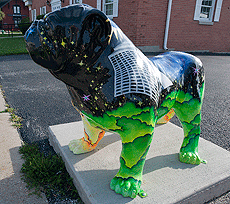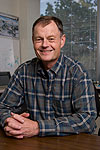|
Have a safe day!
Wednesday, Aug. 24
3:30 p.m.
DIRECTOR'S COFFEE BREAK - 2nd Flr X-Over
4 p.m.
Fermilab Colloquium - One West
Speaker: Michael Lubell, American Physical Society/City College of New York
Title: Science: What the Public is Thinking, What Congress is Doing, How You Can Contribute
Thursday, Aug. 25
11 a.m.
Joint Experimental-Theoretical Physics Seminar - One West
Speaker: Alex Sousa, Harvard University
Title: New Results from MINOS
2 p.m.
Computing Techniques Seminar - FCC1
Speaker: Rajkumar Kettimuthu, Argonne National Lab/University of Chicago
Title: Data Movement Challenges in the Era of 100 Gbit and Terabit Networks
2:30 p.m.
Theoretical Physics Seminar - Curia II
Speaker: Chris Bouchard, University of Illinois, Urbana-Champaign
Title: The Brown Muck of B Mixing: Beyond the SM
3:30 p.m.
DIRECTOR'S COFFEE BREAK - 2nd Flr X-Over
THERE WILL BE NO ACCELERATOR PHYSICS AND TECHNOLOGY
SEMINAR TODAY
Click here for NALCAL,
a weekly calendar with links to additional information.
Upcoming conferences
|
|
Wednesday, Aug. 24
- Breakfast: English muffin sandwich
- Portobello harvest grain
- Santa Fe chicken quesadilla
- Hoisin chicken
- Smart cuisine: Parmesan fish
- Cuban panini
- Assorted sliced pizza
- Shrimp pesto
Wilson Hall Cafe Menu |
|
Wednesday, Aug. 24
Lunch
- Crab cakes w/ remoulade sauce
- Parmesan orzo
- Lemon cheesecake
Friday, Aug. 26
Dinner
Closed
Chez Leon Menu
Call x3524 to make your reservation.
|
|
From sight to insight
Isaac Asimov, the American science fiction and popular science writer, famously said, "The most exciting phrase to hear in science, the one that heralds new discoveries, is not 'Eureka!' (I found it!) but 'That's funny.'"
In a world swimming in information, how does a scientist have such a revelation? How do they find a needle of insight in a growing digital haystack?
They use scientific visualizations, an essential yet often overlooked tool for discovery. The process of visualization converts data—from sensors, DNA sequencers, social networks, and massive high-performance computing simulations and models—into images that can be perceived by the eye and explored and interpreted by the human mind.
This aspect of discovery has always been valuable, but as our ability to simulate subatomic particles, perform high-resolution 3D scans of the body, or map the universe improves, turning that data into useful information is increasingly critical.
In November 2008, the U.S. National Science Foundation requested proposals for "TeraGrid Phase III: eXtreme Digital Resources for Science and Engineering (XD)." The grants funded the first of a new class of computing systems: two state-of-the-art resources at the Texas Advanced Computing Center and the National Institute for Computational Sciences that together increased the visualization and data analysis capabilities of the open science community significantly.
Read more
|
Batavia statue: Fermi-lap dog
 |
|
A mascot for Fermilab stands guard in downtown Batavia. The Hansen-Furnas Foundation sponsors the Fermi-lap dog, one of many decorated bulldogs throughout Batavia. Photo: Reidar Hahn |
|
Rare particle decay could mean new physics
From PhysOrg.com, Aug. 23, 2011
An incredibly rare sub-atomic particle decay might not be quite as rare as previously predicted, say Cornell researchers. This discovery, culled from a vast data set at the Collider Detector at Fermilab (CDF), is a clue for physicists trying to catch glimpses of how the universe began.
The work, which is generating buzz because of its possible implications for the existence of new physics, has been submitted to Physical Review Letters by an international team of scientists, among them Julia Thom-Levy, Cornell assistant professor of physics, and graduate student Walter Hopkins. The paper is available on arXiv.
Thom-Levy studies the decay of particles formed in high-energy collisions, with particular focus on a class of particles called strange B-mesons that consist of a beauty quark bound to a strange quark.
The Standard Model of Physics predicts the rate of strange B-mesons decaying into a pair of oppositely charged muons as exceedingly rare, with only a few decays out of 350 trillion collisions expected.
Read more
|
New neutrino data may explain origins of matter
From The Daily Californian, Aug. 22, 2011
Recent advancement in an international physics experiment run by the Lawrence Berkeley National Laboratory may provide evidence of how matter came to be in the universe.
Berkeley lab researchers, collaborating with 250 physicists and engineers worldwide to form the China-based Daya Bay Reactor Neutrino Experiment, are working to decipher specific properties of neutrinos in order to answer questions about how they function through time and space.
The experiment is currently collecting data about the three “flavors” of neutrinos — electron, muon and tau — and how they morph and combine, which will explain how these particles came together when the universe was created, said William Edwards, a visiting scientist in the physics division at the Berkeley lab and project manager of the Daya Bay experiment.
Read more
|
|
The last lap - Tevatron's end
Roger Dixon, head of the Accelerator Division, wrote this column.
 |
|
Roger Dixon
|
The end of the Tevatron era is fast approaching. This is a poignant time for me. I became involved with this historic machine before it existed. I was involved with testing magnets in beams and with the beam extraction system used early on to deliver beam to the fixed-target experiments. Even though my role was small I could not help but feel that I was becoming a part of history. I often found it necessary to take a few moments to calm down after I got to work. Maybe it was just the coffee in the Main Control Room.
Once the Energy Doubler (the machine that was later renamed the Tevatron) was commissioned I became involved at the other end of the beams, particularly with two fixed-target experiments and in building the DZero detector.
More recently I renewed a direct involvement with the Tevatron when I returned to become the head of the Accelerator Division. These last eight years have been one of the best times in my life. From my role in AD headquarters I was well positioned to experience the satisfaction of working with a truly great team. Even though their accomplishments during these past few years are astonishing, that they persevered through so many obstacles does not comes as a surprise to me. My major responsibility during this time was to allow the division to continue its exemplary performance by keeping the tracks clear.
Building and operating the Tevatron was a big challenge for the laboratory. I remember that while we were working on it there was a good deal of skepticism in the trenches. Nevertheless it came together because the people involved were talented, enthusiastic and believed in their leadership. They developed a spirit that drove them onward despite many difficulties. This spirit has lasted through the many years of the Tevatron’s existence, manifesting itself in our successful operations and in the execution of our other big projects. It is still very much alive today, and it must be maintained if we are to have a successful future. After all, people, more than dollars, are what make the challenging projects spring to life.
The Accelerator Division will miss the Tevatron. We will take a moment of silence on Sept. 30, 2011, and then we will move enthusiastically toward the future with all its challenges.
|
ES&H weekly report, Aug. 23
This week's safety report, compiled by the Fermilab ES&H section, includes two incidents. A service subcontractor felt back pain after using a small hand grinder while bending over an RF cavity. He received first-aid treatment. A guest scientist, travelling out of the country on business, was bitten by a dog and required medical treatment.
Find the full report here. |
|